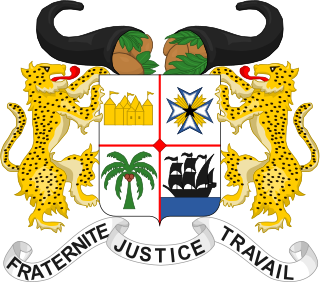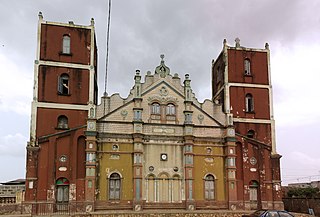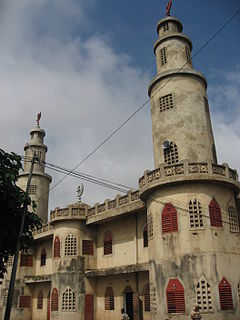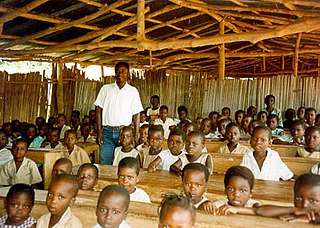
Benin, officially the Republic of Benin and formerly Dahomey, is a country in West Africa. It is bordered by Togo to the west, Nigeria to the east, and Burkina Faso and Niger to the north. The majority of its population lives on the small southern coastline of the Bight of Benin, part of the Gulf of Guinea in the northernmost tropical portion of the Atlantic Ocean. The capital of Benin is Porto-Novo, but the seat of government is in Cotonou, the country's largest city and economic capital. Benin covers an area of 114,763 square kilometres (44,310 sq mi) and its population in 2016 was estimated to be approximately 10.87 million. Benin is a tropical nation, highly dependent on agriculture, with substantial employment and income arising from subsistence farming.

Abomey is a city in the Zou Department of Benin. Abomey is also the former capital of the Kingdom of Dahomey, which would later become a French colony, then the Republic of Dahomey (1960–1975), and is the modern-day Republic of Benin.

Benin is divided into 12 departments, and subdivided into 77 communes. In 1999, the previous six departments were each split into two halves, forming the current 12. Each of the six new departments was assigned a capital in 2008.

Alibori is the largest and northernmost département of Benin. The départment borders the countries of Burkina Faso, Niger, and Nigeria. The départments of Atakora and Borgou also border Alibori. The département of Alibori was created in 1999 when it was split off from Borgou Department. Since 2008, the capital has been Kandi.

Atakora is the northwestern department of Benin, bordering Togo to the west and Burkina Faso to the north. Also, it borders the departments of Alibori, Borgou, and Donga. Major towns in the Atakora include Natitingou and Tanguiéta, and the major tourist areas include the Tata Somba houses, the Pendjari National Park, and various waterfalls. The département of Atakora was bifurcated in 1999, and some of its southern territory was moved to the newly created Donga Department. The capital of the department is Natitingou.

Collines is one of the twelve departments of Benin. The departments that border Collines are Plateau, Borgou, Zou, and Donga. The main ethnic groups in the department according to the National population census are Yoruba of the Nagot group at 46.8% and the Yoruba of the Idaasha at 14.9% for a total of 61.7% to constitute the majority, the Yoruba group is followed by the Mahi at 25.7% or just over a quarter of the regional population, while the Fon represent 13% of the population. The département of Collines was created in 1999 when it was split off from Zou Department. Since 2016, the capital is Igbo Idaasha, known as Dassa Zoumé.

Littoral is one of the twelve departments of Benin. Littoral is the smallest department of all of the twelve in the country, as well as the most cosmopolitan. Its capital is Cotonou, Benin's largest city. The area is 79 km2 (31 sq mi). The department of Littoral was created in 1999 by splitting territories from Atlantique Department.

Ouémé is one of the twelve departments of Benin. It is subdivided into nine communes, each centered at one of the principal towns, namely, Adjarra, Adjohoun, Aguégués, Akpro-Missérété, Avrankou, Bonou, Dangbo, Porto-Novo and Sèmè-Kpodji. In 1999, the northern section of Ouémé was split off to form the department of Plateau.

Zou is one of the twelve departments of Benin. The department obtains its name from the Zou River which travels through the department before emptying into the Atlantic in the south of the country. The majority of the population are the Fon people with 91% population, while Aja people make up 4% and Yoruba make up 3% of the populace. The departement of Zou was split in 1999 with the northern territory moved to the newly created Collines Department. The capital of Zou is Abomey. Zou is subdivided into nine communes, each centered at one of the principal towns, namely, Abomey, Agbangnizoun, Bohicon, Cové, Djidja, Ouinhi, Za-Kpota, Zangnanado and Zogbodomey.

Plateau is one of the twelve departments of Benin. The population is predominantly Yoruba of the following subgroups: Nagot group at 45.7% and the Ohori at 20.9% for a total of 66.6% to constitute the majority. The Yoruba group is followed by the Fon group of the following subgroups: Guns at 12.4% of the population, Fon at 8.2% of the population, and Torri 6.5%. The département of Plateau was created in 1999 with an area of 2,835 sq. km, when it was split off from Ouémé Department. Plateau is subdivided into five communes, each centered at one of the principal towns, namely, Adja-Ouèrè, Ifangni, Kétou, Pobè and Sakété.

Mono is one of the twelve departments of Benin. The capital of Mono is Lokossa. Some territories of Mono were moved to the newly formed Kouffo Department during 1999. Mono is subdivided into six communes, each centered at one of the principal towns, namely, Athiémè, Bopa, Comè, Grand-Popo, Houéyogbé and Lokossa. It has an area of 1,396 sq. km.

Donga is one of the twelve departments of Benin. The capital of Donga is Djougou. The département of Donga was created in 1999 when it was split off from Atakora Department. Donga is subdivided into five communes, each centered at one of the principal towns, namely, Bassila, Copargo, Djougou Rural, Djougou Urban and Ouaké.

Atlantique is one of the twelve departments in Benin. The department is located in south central Benin along the Atlantic coast, between the Mono and Couffo in the west, Zou in the north, and Oueme in the east. Ethnically, the Fon at 61% constitute the majority of the population. They are followed by the Yoruba at 10%, Aja at 7%. Other groups make up the remaining 22%. Important towns in the department include Allada, Ouidah, Abomey-Calavi and Godomey. The département of Atlantique was bifurcated during 1999 when some of its territory were moved to the newly formed Littoral Department.

Kouffo is one of the twelve departments of Benin. Kouffo borders the country of Togo and it also borders the departments of Mono, Zou, and Atlantique. Since 2008, the capital is Aplahoué. The département of Kouffo was created in 1999 when it was split off from Mono Department.

Borgou is one of the twelve departments of Benin. Borgou borders the country of Nigeria and the departments of Alibori, Atakora, Collines and Donga. The capital of Borgou is Parakou. The département of Borgou was bifurcated in 1999 with its northern territory moved to the newly created Alibori Department.

The departments of Benin are subdivided into 77 communes, which in turn are divided into arrondissements and finally into villages or city districts. Prior to 1999 provinces were broken down into 84 districts, titled either urban or rural. Before independence, the six provinces were subdivided into Cercles, cantons, préfectures and villages or towns.

The unicameral National Assembly is Benin's legislative body.

Lesbian, gay, bisexual, and transgender (LGBT) persons in Benin face legal issues not experienced by non-LGBT residents. Although same-sex sexual acts for both men and women are legal in Benin, homosexuals continue to face widespread persecution and are rarely open about their sexuality.

Benin has abolished school fees and is carrying out the recommendations of its 2007 Educational Forum. In 1996, the gross primary enrollment rate was 72.5 percent, and the net primary enrollment rate was 59.3 percent. A far greater percentage of boys are enrolled in school than girls: In 1996, the gross primary enrollment rate for boys was 88.4 percent as opposed to 55.7 percent for girls. The net primary enrollment rates were 71.6 percent for boys and 46.2 percent for girls. Primary school attendance rates were unavailable for Benin as of 2001.



















